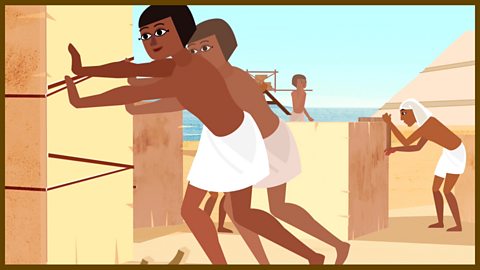Exploring pyramids in Ancient Egypt - their construction, purpose and the ways they evolved before falling out of fashion.
This is a tool that the Ancient Egyptians used. See the way it's a bit broken?
Well, that's because it's very old. We call this kind of object an artefact. An artefact gives us a little window into another timeand this one helps us travel back nearly 5000 years to the Old Kingdom in Ancient Egypt.
The Ancient Egyptians built pyramids as giant burial tombs for the most important people in their society, the pharaohs.
Inside each of these pyramids is a mummy.
Mummy: Hi ya! You all right?
Not that sort of mummy, I mean the mummified remains of the pharaoh.
Mummy: Oi!
Mummification was the way in which they prepared the body for burial.
This involved removing all of the moisture from the body, including most of the organs which they stored in special jars calledcanopic jars - yuk gross!
The pharaoh's death was seen as the beginning of their journey towards eternal life.
So it was important that their body was preserved to be as lifelike as possible.
The mummified body was buried safely in the pyramid with the items they would need for life after death.
Our artefact was a very important invention that allowed Ancient Egyptians to build the huge pyramids with amazing accuracy and precision.
It's called a set square and plumb line and was used to make sure the pyramids were straight and level from foundations up.
In fact, a very similar tool is still used today for exactly the same thing.
A surveyor working on the pyramid would place the two ends of the wooden set square on a surface and if the weight of the stone, on the plumb line, pulled it down exactly between the two ends of the set square then it was level.
If not? Well then they needed to make adjustments.
Foreman: No good! Next!
Pyramids were built over a period of about 700 years and during that time designs were refined and improved with trialand error.
Pharaoh: Start again!
The first pyramids were 'step' pyramids pioneered by the Pharaoh Djoser, who made his burial tomb taller by stacking stone layers.
Around 50 years later, the Pharaoh Sneferu decided he wanted a smooth finish on the outside of his pyramid.
And so began a kind of competition with each new pharaoh making their pyramid better, stronger and more complex than the one before.
We know who ordered the pyramids but who actually built them?
This was important work that skilled workers took great pride in doing. Farm workers also came to help when the farmland was too wet to work.
The largest pyramids were made with over 2 000 000 blocks of rough yellow limestone that were taken from the ground on site.
Most of the blocks were cut in the ground and then prized out using wooden levers.
To move the heavy stone they used large wooden sleds which they pulled over wet sand.
Exactly how they got the blocks up higher for each level is still a bit of a mystery.
It's thought that they may have used a combination of ramps and a pulley system to heave the sleds up to the height they needed.
It's no accident that the Ancient Egyptians didn't leave any records of how they built the pyramids.
It seems that they wanted them to appear like magical stone mountains from another world.
Wow! They really are impressive.
Pyramids
Video summary
This video gives pupils an understanding of the pyramids of Ancient Egypt and what we know about how they were built.
It helps to unearth some of the mysteries surrounding the pyramids and why they were important to the Ancient Egyptian people.
As the video progresses we see in more detail the process of mummification and what exactly went into a pyramid once it was built.
We also explore a key source which in this video is the set square and plumb line. This source is a tool that was used to ensure the pyramids were built level and accurately, giving them the strength that has kept many of them standing to this day!
We chart the how the design of pyramids evolved over time as building methods and the preferences of the pharaohs changed.
The video explains some of the mysteries surrounding the design and building of the pyramids, but reminds pupils that the Ancient Egyptians wanted some of the elements to remain a mystery.
Further resources
Click to display the image full-size
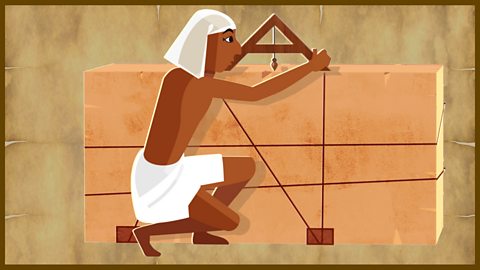
Click to display the image full-size
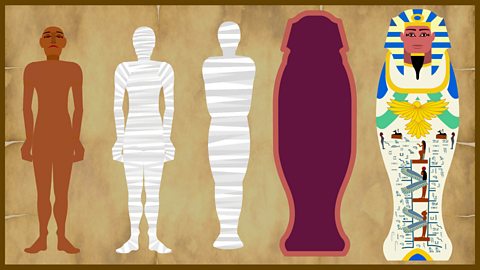
Click to display the image full-size

Teacher's Notes
This video gives a snapshot of Ancient Egypt and how important the pyramids were to the people of the time. It provides a platform to discuss faith and belief and how important the pharaohs were in Ancient Egyptian life and culture.
It can be used to help pupils understand how we find out about the past and the role of sources in this exploration. We find out how the pyramids were built and this provides a platform for investigation in Science in relation to forces and the properties of materials.
The video provides an opportunity for pupils to discuss where they think remains of pyramids would be found today and to complete map work based on this, justifying their choices and giving reasons for their points of view.
Points for discussion (History Linked)
- What is a pyramid?
- Why were the pyramids so important to the Ancient Egyptians?
- How do we think the Ancient Egyptians built pyramids?
- What is a set square and plumb line?
- What went into a pyramid?
- Over how many years were the pyramids built?
- How do you think the Ancient Egyptians got the heavy blocks from the ground up to the top of the pyramids?
Suggested Activities (Cross Curricular opportunities)
Building a Pyramid â Using a variety of resources from home or school (such as sugar cubes), can the pupils build their own pyramid? What factors do they have to consider when placing items on top of each other to make the shape stable? Explore how they could improve their design if they were to build it again.
Finding the area of a pyramid â Using a variety of shape nets, can the pupils work out the area of different pyramids? Using their understanding of length x width for area of a square or rectangle and half x base x height to find the area of a triangle, can pupils find total areas in mm squared and cm squared?
Make a set square and plumb line â Using wooden sticks or dowels, string and stones can pupils build their own working set square and plumb line? And test how level things are around the classroom? Is will be important to get the angles right and find ways of fixing the wood securely. What worked well and what would they change to make the tool work better for them?
Creative Writing â How must it have felt to have been working on building the pyramids? Using photographs and the ideas from the video clip, can pupils write a diary entry or recount text to explore what life building a pyramid was like? How did working in the extreme heat affect them? Was there a sense of satisfaction when the pyramid was complete? How did those heavy blocks really get moved to the top of the pyramid?
Creating a mummy â The Ancient Egyptians found that the hot and dry condition of the sand in Egypt helped dry out and preserve the bodies of the pharaohs. Can the pupils test this finding? Using two pieces of bread or home-made play dough, place one in an airtight container or bag alone and other in the same container but with sand. Leave the one with sand close to a radiator and the other away from a heat source. Watch and observe over time and see which begins to change as it rots first. Were the Ancient Egyptians onto something with their mummification process?
This film is relevant for teaching History at KS2 in England, Wales and Northern Ireland and 2nd Level in Scotland.
Gods and goddesses. video
Exploring the many gods and goddesses of Ancient Egypt and their various roles within society.
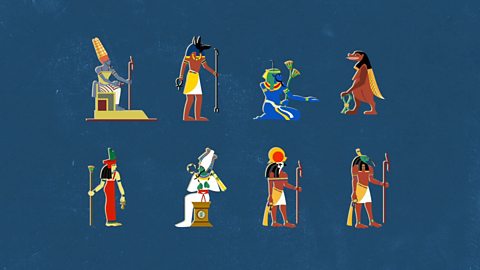
King Tutankhamun. video
Exploring the life and death of King Tutankhamun and the excavation of his tomb in 1922.
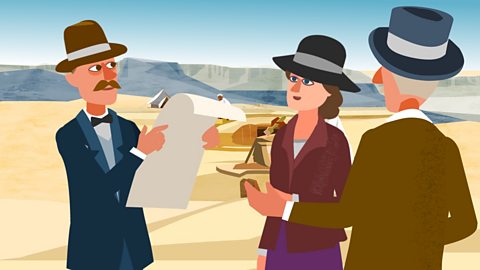
Rames - The Engineer. video
Rames is 12 years old and about to join the thousands of workers constructing the pyramids.

See also...
KS2 Music: Ancient Egypt. collection
A collection of fun, catchy songs and activities to help you consolidate your study of Ancient Egypt.
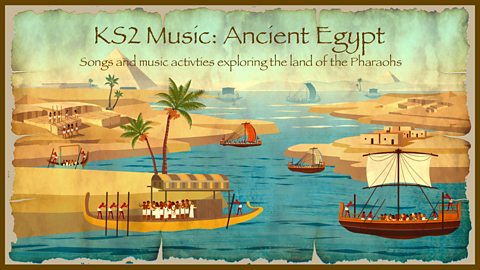
Song: 'Build that pyramid'
Join in with a lively work song about the building of the pyramids in Ancient Egypt.
